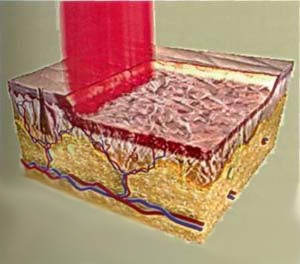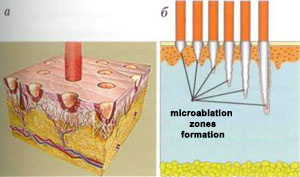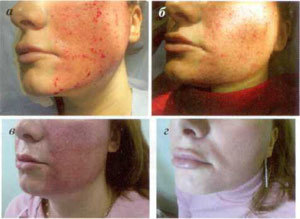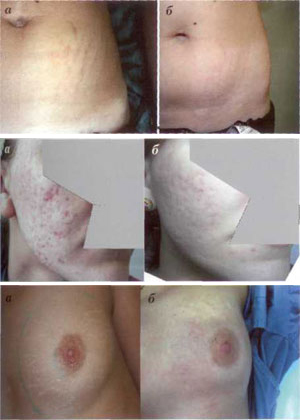Today, in the arsenal of modern dermatocosmetology, there is a fairly wide range of methods for correcting various aesthetic imperfections of the skin - chemical peeling, mechanical dermabrasion, laser dyeing, microdermabrasion, contouring. Nevertheless, new trends and technologies in the beauty industry are constantly evolving and evolving.
This trend is particularly prevalent in hardware methods, especially laser medicine. The use of lasers has an impressive period first in dermatology and then in cosmetology. One of the latest appearances since laser treatment methods - selective photothermolysis - has passed more than 25 years. The pioneers of this direction, American Americans RR Anderson and JA Parrish, predetermined the fate of fractionated lasers in medicine and made them indispensable in such aesthetic treatments. skin defects such as capillary hemangiomas. Port wine stains, hypertricosis, tattoos, rosacea, pigmentation disorders, photoaging, wrinkles, etc.
Modern skin transformation techniques
We live in a time when more people are getting older than ever. And as many of them continue to live active lives, one of the most important problems in aesthetic medicine is the fight against aging skin.
Plastic surgery rejuvenates the shape of the face by removing excess skin. However, the skin is still altered by time (age-related aging) or external factors (light age). It is also important that most patients want this to look younger without surgery.
In this case, what method should be used to affect the skin, and what should be done about it in order to truly regenerate the skin?
All methods to improve the appearance of the skin are combined in one principle - they have a traumatic effect on the skin, provoking fibrosis, which further tightens and compresses.
Currently, dermatocosmetology uses three main types of skin rejuvenation, including:
- chemical stimulation - chemical peeling with acids (trichloroacetic acid, glycolic, etc. );
- mechanical stimulation - mechanical dermabrasion, microdermabrasion, mesotherapy, fillers, needle substitution;
- thermal stimulation - laser ablation, thermal excitation using lasers and broadband light sources, radiofrequency boosting, fractional methods.
Chemical stimulation
Historically, peeling acids has been the first way to regenerate the skin. The principle of exfoliation is partial (as in the case of superficial exfoliation) or almost complete (in the case of middle and deep peeling) the epidermis is destroyed by fibroblasts and dermal structures. This damage activates the inflammatory response (the stronger, the greater the volume of destruction), leading to additional collagen production in the skin.
However, in order to achieve the desired result, peeling must sacrifice the peel. Burning experiments have deceived a lot, supposedly “proving” that the epidermis is a self-renewable organ that quickly recovers from damage to the underlying area. In this regard, exfoliation has become increasingly aggressive to the epidermis for some time (e. g. , deep phenolic exfoliation), until eventually the accumulated problems have led professionals to recognize its evil. a method that eventually leads to thinning of the skin.
Supporters of deep exfoliation did not consider the issues that arose. The point was that due to the destruction of the papillae of the dermis and the weakening of the diet, the epidermis becomes thinner and the number of cells in the spiky layer decreases significantly. with what was before peeling. Decreased barrier function of the stratum corneum leads to decreased hydration of the skin. (Therefore, almost all patients experience severe dry skin after prolonged deep peeling. ) However, putting lighter peels (using trichloroacetic acid and fruit acids) into practice did not live up to their hope of effectively tightening the skin.
Mechanical stimulation
In terms of mechanical stimulation of involuntary changes in the skin, dermabrasion deserves special attention with rotational means (at speed v; rotation of cutters up to 100, 000 rpm). Currently, modern Schumann-Schreus devices are used (Germany)
The method can only be used in a surgical hospital, as the procedure requires anesthesia, postoperative treatment of the wound surface, a special toilet for the eyes and mouth, and equipment for feeding patients (due to thepostoperative edema makes it difficult to open the eyes and mouth).
The method is very effective, but unfortunately there is a high risk of the following complications in case of mechanical dermabrasion:
- persistent postoperative hyperemia;
- appearance of depigmentation areas due to melanocyte death when the cutter penetrates the basement membrane;
- wound surface infection;
- scarring (if the cutter is too deep into the skin)
Each of the above determines the limited application of this method in clinical practice.
Thermal stimulation
Ablative Transformation
Since the late 1980s, lasers have been used to rejuvenate skin by removing layer-by-layer tissue (ablation) [4]. Careful, traumatic removal of the surface layer of the skin with the help of a carbon dioxide laser stimulates the synthesis of the collagen contained in it, the amount of which increases several times after the procedure. It is then gradually reorganized.
The most effective was the use of a CO2 laser when all layers of the dermis were exposed to deep heat caused externally by tightening the skin. The method is called “laser dermabrasion” or “laser” repainting ”and cannot be inconsistent in terms of effectiveness with any other method of skin renewal that existed at the time (Figure 1).

Figure1. Scheme of traditional laser skin staining (laser dermabrasion)
However, the CO2 laser also causes a number of complications. In addition, further studies have shown that such a profound effect on the dermis stimulates the formation of fibrous tissues to a greater extent than a new, normally synthesis-oriented collagen contributes [5]. Due to the fibrosis that has developed, the skin may be unnaturally pale. Collagen synthesized after treatment is absorbed after a few years, as is collagen formed at the site of the scar. As a result of dilution, fine wrinkles begin to appear on the skin in the epidermis caused by atrophy of the papillary layer of the dermis. Due to the impaired barrier function of the stratum corneum, the level of hydration in the skin decreases and appears atrophic.
Erbium-aluminum-yttrium-garnet-erbium lasers appeared a little later. The benefits of an erbium laser include a shallower heat penetration depth (erbium lasers penetrate to a depth of 30 microns, CO2 lasers penetrate up to 150 microns) and (as a result) a lower risk of burns and tissue carbonation, as well as relative cheapness (compared to carbon lasers) has attracted the attention of many professionals around the world.
Nevertheless, as experience with the two types of equipment has accumulated, there is a perception among professionals that CO2 lasers are more efficient [6]. Despite the negative effects of carbon dioxide laser dermabrasion described above, this method remains indispensable for the correction of acne scars. It can also be seen as an alternative to surgical skin pulling - with all its modification methods, only exposure to the CO2 laser can cause a pronounced collagen contraction with a visible clinical lifting effect.
The problem with all of the methods described above is that they are often “sacrificed, ” meaning they cause significant damage to the epidermis. In order to rejuvenate your skin and make it look really young, you need perfect, natural skin, good hydration, normal skin tone and elasticity. The epidermis is a very complex, very specialized organ, up to 200 microns thick, this is the only protection against the effects of negative environmental factors. Therefore, whatever we do to rejuvenate the skin, we must ensure that the normal structure of the skin is never damaged.
This concept contributed to the advent of non-ablative skin remodeling technology.
Non-ablative transformation
The most common tools for non-ablative skin remodeling are neodymium (Nd-YAG) and diode lasers, as well as broadband light sources (IPL). The principle of their action - selective photothermolysis - consists in heating and destroying the structures, containing a sufficient amount of melanin or oxyhemoglobin. In the skin, these are the accumulation of melanocytes (lentigo, melasma) and micro-compounds (telangiectasia). Emitted wavelengths used in non-ablative lasers: correspond to the maxima of the absorption spectrum of oxyhemoglobin or melanin. Treatment with non-ablative lasers and IPL is quite safe, the rehabilitation period is minimal, however, such treatment only removes cosmetic defects in the pigmentary and vascular system. In this case, the skin may thicken to some extent, but the effect obtained is short-lived.
fractionated skin remodeling techniques
The constant search for new, highly effective and at the same time safe methods of skin rejuvenation has led to a revolutionary new technology - the partial delivery of laser radiation. The proposed skin rejuvenation method is specifically designed to overcome some of the above difficulties. Unlike "traditional" ablative and non-ablative laser methods, which aim to achieve uniform thermal damage to the skin at a uniform depth, fractional methods allow for selective microscopic thermal damage in the form of a number of altered columns and leave untouched areas around these microspheres. Currently, the industry produces two types of fractional lasers: non-ablative and ablative.
The first uses an erbium-doped optical fiber that generates radiation at 1550 nm. The fractionated laser forms thousands and tens of thousands of microforms in the skin in the form of columns - microthermal treatment zones (MLZ) - 70-150mk in diameter up to 1359mcm
As a result, approximately 15-35 skin photocoagulates in the treated area. The chromophore of the laser is water, coagulation occurs primarily in the lower layers of the epidermis and dermis. The cornea remains intact because it contains a relatively small amount of water and this significantly reduces the risk of infection. Epidermal healing is rapid due to the low lesion count and short migration distance of keratinocytes. The healing period is accompanied by moderate edema and hyperemia, followed by exfoliation, which 5-7. appears on day. The patient practically does not lose his social activity.
This technology - fractional photothermolysis (FF) - is an extremely efficient method for non-ablative fractionated skin transformation. Treatment is prescribed to achieve the desired effect. Depending on the clinical situation, it is recommended to perform 3-6 procedures for 4-6 weeks. As with all other non-ablative skin care methods, the end result is only visible 4-8 months after the procedure (cumulative effect).

Fractional ablation (FA or fractional deep dermal ablation - FDDA) is used in cases where there is a more aggressive effect on the skin - to repair scars, remove deep wrinkles and excess skin.
The fractional ablation method combines the benefits of a CO2 laser with the fractionated principle of laser radiation. Unlike traditional CO2 lasers, which remove the entire surface of the skin from layers, FA units form a huge number of microablation zones (MALs) up to 300 µm in diameter at an evaporation depth of 350–1800 µm (Figure 2).
Thus, in this procedure, the laser radiation that penetrates the deep layers of the skin destroys the top layer of the epidermis. In terms of efficiency, ablative fractional laser rejuvenation is comparable to plastic surgery, so the laser beam goes back.
Figure2. The principle of operation of the ablative fractional laser: formation of microablative zones - MAZ (a); dependence of MAZ formation depth on laser radiation power (b)
As with FF, 15-35% of the skin in the treated area is actually exposed (up to 70% in some cases). Recovery is faster after the FA procedure than after layer-by-layer ablation. This is due to the fact that a significant part of the epidermis and a portion of the cornea remain intact. Skin bleeding is observed for some time immediately after surgery but stops soon (Fig. 3a, b).
Figure3. Step-by-step skin recovery after the fractionated ablation procedure: viewing immediately after treatment (a); every other day (b); After 5 days (c); 14 days (d) after a procedure

There are a number of micro-hemorrhages in the dermis that induce a complex change in change that leads to the production of new collagen. After the bleeding has stopped, the serous fluid remaining on the surface of the skin should be removed. Its release is monitored within 48 hours after the procedure until complete epithelialization of the microablastic zones occurs. During this period, the patient uses special wound healing external agents. Usually, peeling and swelling begin to increase after 3-4 days (Fig. 3 c). On day 7, these phenomena gradually resolve and erythema is the only noticeable side effect (Fig. 3d). The duration of erythema depends on the parameters of laser exposure and are characteristics of skin vascularization. The author observes that erythema lasts for up to 3 months.
Loss of patient social activity lasts 5-10 days after FA procedure.
Skin should be carefully cared for to avoid scarring and post-inflammatory pigmentation. Decorative cosmetics can be used for 4-5 days. A prerequisite for a good result is at least three months after high-protection sunscreen cosmetics (SPF at least 50). The risk of post-inflammatory pigmentation occurs in 20% of patients and is generally higher in patients with cutaneous IV-V phototypes. Such hyperpigmentation is transient in nature and can last from 1 week to 3 months, depending on the depth of treatment and the area of treatment. To prevent this, external agents based on hydroquinone (4%) and tretinoin (0. 1%) are prescribed 1-2 weeks before the procedure and for a further 2 weeks thereafter. The main effects on the facial skin after FA treatment are: firm tightening and unnecessary skin reduction, skin smoothing of the surface, as well as skin affected by acne, reduction of dyschromia, porosity.
This method has also been tested by the author and colleagues to remove skin stretch marks. As clinical trials show, the method has been highly effective in removing almost all types of stretch marks that stretch during puberty. period and postpartum period. It has been observed that the healing processes on the body skin differ from the healing processes on the facial skin
The mechanism of skin remodeling when using fractionated lasers
Investigate the mechanisms of skin remodeling using fractional lasers.
After contact with the laser, aseptic inflammation develops in the area of the micro-wounds formed. The more aggressive the laser exposure, the stronger the inflammatory response that actually stimulates post-traumatic release growth factors and infiltration of damaged tissues with fibroblasts. The reaction is automatically accompanied by an explosion of cell activity, which inevitably leads to the fact that fibroblasts produce more collagen and elastin. The process of skin remodeling involves three classic phases of regeneration:
- I. phase change (tissue inflammation). It starts immediately after the injury;
- Phase II - proliferation (tissue formation). It starts 3-5 days after the injury and lasts for approx. Lasts 8 weeks;
- Phase III - Tissue Transformation. It lasts from 8 weeks to 12 months.
It should be noted that all three stages of skin remodeling are observed after both fractional photothermolysis and fractional ablation. But in the first case, the detrimental effect of the laser is moderately aggressive, resulting in the inflammatory cascade entering a half change never very wild.
A completely different image is observed after exposure to a fractionated ablation laser. The trauma caused by this laser ruptures in the blood vessels and the blood cells, as well as the serum, are released into the surrounding tissues. The mechanism of regeneration of the skin of the whole person - the change of trees begins - aseptic inflammation develops. Platelets released from damaged blood vessels play an important role in activating blood clotting and releasing chemotoxic factors, which in turn are attracted by other platelets, leukocytes, and fibroblasts. Leukocytes, especially neutrophils, are involved in the purification of dead tissue, removing fragments of necrotic tissue that are partially destroyed by phagocytitis and partially released to the skin surface in the form of microscopic debris made from epidermal and dermal tissue substrates and melanin-microepermalstands.
The proliferation phase is approx. It starts within 5 days. During this period, neutrophils are replaced by monocytes. Monocytes, keratinocytes, and fibroblasts continue to affect growth factors and at the same time are under the opposite effect. Keratinocytes stimulate epidermal growth and the release of growth factors needed to stimulate the production of collagen by fibroblasts. During this phase, new blood vessels form and the extracellular matrix is intensively formed
The last reconstructive healing phase lasts for several months after fractionated laser exposure.
On day 5 post-injury, the fibronectin matrix “fits” along the axis along which the fibroblasts line up and along which collagen builds up. Transformation of β growth factor (a strong chemotoxic agent in fibroblasts) as well as other growth factors play an important role in matrix formation. In the early stages of wound healing, the main form of collagen is III. Type of collagen (this type of collagen is located in the upper layer of the dermis, just below the base layer of the epidermis). The longer the modification phase, the more type III collagen it will produce, but in any case, the amount will increase for 5 to 7 days after injury. Type III collagen is gradually replaced by collagen over a period of about one year. type that strengthens the strength of the skin. Blood circulation gradually normalizes, the skin becomes smoother and gets a natural color.
Comparative analysis of laser methods of skin remodeling
To summarize the above, here is a diagram showing the relationship between the effectiveness and safety of laser skin reshaping methods.
Advantages of fractional track rejuvenation methods. The advantages of fractional methods used in clinical practice are:
- minimized skin damage. Histological examinations after surgery show an increase in the number of papillae in the skin, which characterizes skin changes as productive regeneration;
- effective rejuvenation: the skin becomes thicker, significantly (more than 400% (! )) increases the production of collagen and elastin;
- short recovery time: average 3 days after FF and 7-14 days after PA;
- minimal risk of hyperpigmentation;
- possibility to perform the procedure in patients with thin skin;
- the ability to have a healing effect on any part of the body;
- Possibility of using a light type of anesthesia: fractional photothermolysis uses only local anesthesia; fractional ablation requires a combination of conductivity and infiltration anesthesia;
- disappearance of telangiectasias (due to the fact that there are so many sites of vascular rupture that recovery is impossible). xx / li>
Main indications for partial treatments

Indications for fractional photothermolysis:
- increase in skin density in the early stages of aging. The FF procedure is relatively simple and can be administered without fear. The therapeutic effect can be applied to the neck, décolletage, arms, abdomen, thighs, mammary glands;
- skin photoaging;
- hyperpigmentation, melasma;
- hypertrophic scars;
- stretch marks.
Indications of fractional ablation:
- Wrinkles of varying severity - from fine lines to strongly pronounced (in the form of furrows);
- age-related loss of skin elasticity and firmness;
- Excess skin on eyelids, neck, face (as an alternative to plastic surgery);
- uneven leather texture;
- Definite skin photography;
- acne scars;
- cicatricial deformity of the skin after injuries and surgeries;
- hyperpigmentation: melasma, lentiginosis, spotted pigmentation, etc.
- vascular dyschrome;
- skin stretch marks;
- actin keratosis.
- on the one hand, laser skin remodeling is recognized today as the most effective;
- Second, the range of aesthetic and dermatological problems solved by these methods is extremely wide - from skin rejuvenation to the treatment of congenital and acquired skin pathologies;
- Third, with the advent of fractional technologies, the safety and efficacy of treatment have become predictable.















































































